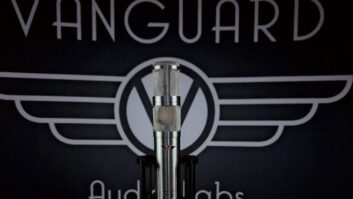
The A Designs Audio MP-2r ($2,650 list) is a higher-gain version of the company’s MP-2 tube preamp, adding an additional 14 dB of gain capability to the latter unit. A Designs Audio markets the all-tube MP-2r as a ribbon preamp (hence the “r” suffix in the model number). While the unit’s input impedance (specified to be greater than 100 kilohms) is plenty high for use with ribbons, such low-output mics often require more than the 60dB maximum gain that the MP-2r delivers. That said, this great-sounding mic preamp has far wider applications than just with ribbon mics (and, in fact, also provides defeatable phantom power to drive condensers).
MONO A MONO
Despite its designation as a stereo unit, the MP-2r employs a dual-mono topology and control layout. Each of the unit’s two independent channels are served by a continuously variable level (attenuation) control and polarity, phantom power and output impedance switches. The latter switch’s 600-ohm setting reveals the preamp’s broadcast origins. I found the alternate 10k-ohm setting provided more presence, transparency, detail, depth and output level for recording applications, although the 600-ohm setting was useful for producing a pillowy electric bass guitar tone.
Each channel also sports a beautiful, backlit VU meter. The meter’s 0VU reading is calibrated to 0 dBu, which is too low for many direct-to-disk recording applications. The MP-2r’s meters were pegged much of the time while recording various sources straight to MOTU’s Digital Performer, even with my Apogee Rosetta’s calibration trims boosted to the max to +4dBu = -10dBFS reference. (Less output level was required from the MP-2r to attain 0 dBFS.) On tracks in which a compressor also supplied makeup gain, I could lower the MP-2r’s output level that much more so that the meters were not pinned nearly as often. But dynamics processing and low preamp gain are not always desirable, and, clearly, the VU meters are not set up to handle the unit’s maximum output level of +22 dBu nor do they indicate remaining headroom. A beefy power switch and large, red power status lamp finish off the MP-2r’s attractive front panel.
The unit’s rear panel sports a separate Neutrik combo input jack and balanced XLR output jack for each channel. The combo jack accommodates either balanced XLR or unbalanced ¼-inch phone jack input, the latter for direct injection of a musical instrument. Thankfully, all I/O connectors latch. An IEC power receptacle mates with the supplied detachable AC cord.
The MP-2r’s well-ventilated, 2U rackmountable chassis houses Jensen input and custom-wound output transformers; 6NI-P and EF86 tubes (one each per channel) sweeten the audio path. The MP-2r’s frequency response is stated to be 20 to 60 kHz, with no tolerances given.
STRAIGHT TO THE TEST
I A/B’d the MP-2r with my Universal Audio 2-610 mic preamp on male lead vocals using an AKG TLII condenser in omni mode. The MP-2r’s output impedance was set to 10 kilohms and the 2-610’s gain control to +5 dB. The MP-2r had a smoother frequency response and produced more detailed transients and more prominent highs and bass frequencies compared to the 2-610, while the 2-610 lent more presence to midrange frequencies. Both preamps sounded extremely lush, but the MP-2r was creamier while the 2-610 had more texture.
Next, I plugged my ’62 Strat into a Roland Micro Cube guitar amp (set to a slightly overdriven Classic Stack amp model) and miked the cabinet with a Coles 4040 ribbon mic routed to the MP-2r. The 4040 has a huge proximity effect, necessitating placing it a full three feet from the cabinet to get enough definition. The MP-2r and Coles 4040 delivered a warm, smooth and full-bodied rock guitar sound. Substituting a Royer R-121 ribbon mic for the 4040 revealed a little more of the source’s crunchy midrange texture while remaining exquisitely warm. The MP-2r contributed a little noise to the result with both ribbon mics (the preamp’s EIN is rated to be -118 dB), but it was only discernable when the track was soloed.
Next up was a trumpet miked 39 inches away with a Coles 4040 on-axis. The MP-2r handled the high SPL without distorting. The track sounded fabulously warm and smooth. In fact, it was one of the best timbres I’ve ever captured while recording trumpet.
Finally, I recorded electric bass guitar plugged directly into the MP-2r’s combo jack. This was my favorite application for the MP-2r. The preamp provided plenty of gain to record a DI’d passive instrument directly to disk. The preamp’s 10k output impedance setting gave deeper bass extension and more presence to the sound than the 600-ohm setting. Using the 10k setting and compressing the preamp’s output with my Universal Audio LA-2A, the sound was absolutely gorgeous. The MP-2r de-emphasized fret noises and provided a rich, yet nicely focused, sound with a very deep bottom. In a subsequent A/B comparison with my Aguilar DB 900 tube DI, the MP-2r produced less midrange presence, more pronounced upper-bass frequencies and a more saturated sound on DI’d electric bass guitar. Both units sounded great — just different.
A SMALL WISH LIST
I hope that A Designs Audio recalibrates the MP-2r’s VU meters to a higher reference level because the current fixed setting is the only substantial flaw in an otherwise wonderfully executed design. Of course, this has no influence on the MP-2r’s smooth sound, which ultimately makes this preamp a worthy addition to any pro studio.
A Designs Audio, dist. by TransAmerica Audio, 702/365-5155, www.transaudiogroup.com.
Mix contributing editor Michael Cooper is the owner of Michael Cooper Recording, located in beautiful Sisters, Ore.







